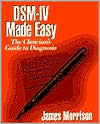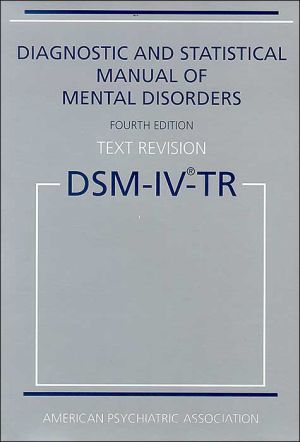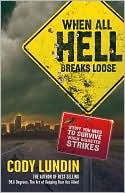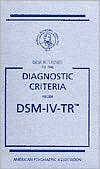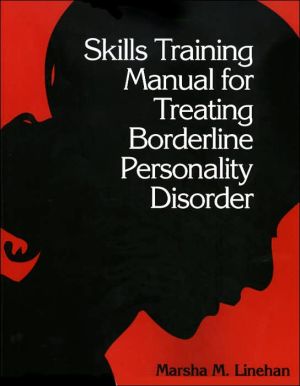DSM-IV Made Easy: The Clinician's Guide to Diagnosis
DSM-IV presents a challenging task for all clinicians. Just reviewing the diagnostic standards is time consuming and often confusing even for the most experienced practitioner; and what is more, learning the standards alone does not immediately translate into clinical application.\ \ This book helps professionals quickly learn how to apply the diagnostic criteria to patients. Every DSM-IV diagnosis is simplified and clearly interpreted, emphasizing what the clinician needs to know most when...
Search in google:
Accessibly written and easy to use, this comprehensive book covers everything professionals and students need to know about DSM-IV. Following the same format as DSM-IV, the text presents every diagnosis. For each it includes case examples, a detailed analysis of each case, and a clear explanation of how to arrive at the diagnosis and how to rule out other possibilities. Essential for all mental health practitioners studying for their licensing exams, this hands-on resource will be valued by psychiatrists, residents, psychologists, marriage and family counselors, social workers, and anyone who needs to know about DSM-IV. Sahana Misra This book presents the information contained in the DSM-IV in a user-friendly way. The criteria for making diagnoses are clearly explained and are accompanied by clinical vignettes, chapter outlines, tips, and coding notes. The purpose is to make the DSM-IV easier to understand and more applicable for clinical use in all mental health professions. This book is primarily targeted at mental health professionals and psychiatry residents. However, because of its well-written and simplified text, it would make an excellent book for medical students during their psychiatry rotations and for other students in mental health fields. Each chapter begins with a quick guide that provides an outline of the diagnoses to be discussed. In this section, cross-references are provided for other diagnoses that may have similar symptoms. Interspersed within the text are valuable tips providing definitions to some vague terms used in the DSM-IV as well as interesting historical information. There are several clinical vignettes provided in each chapter that help to elucidate the diagnoses even further. This book provides a simplified and thorough explanation of the material presented in the DSM-IV. It is a useful source of information that can be used as a primary text for students and as a supplemental text for all mental health professionals. It also would be a practical addition to any health sciences library.
\ From the Publisher"DSM-IV Made Easy helps the mental health clinician arrive at the most appropriate diagnosis for a given patient. This well-written, easy-to-read volume not only lists the applicable criteria, but also discusses them and provides useful tips about many disorders. Case vignettes supplement the text and add 'clinical flavor' to our classification system. A most useful guide for practitioners."--David L. Dunner, MD, FACPsych, Director, Center for Anxiety and Depression, and Professor Emeritus, Department of Psychiatry and Behavioral Sciences, University of Washington "An extremely useful text....Morrison has put 'life' into the DSM-IV criteria with his strategic use of strong vignettes and important 'tips' for using psychiatric code....A real contribution to the thorny problem of constructing meaningful descriptions of patients' difficulties." --Jane Close Conoley, Ph.D.\ "Morrison's guide is an accurate and well-organized companion to DSM-IV and is most useful for medical students, psychiatric trainees, professionals in mental health, and coders who use DSM-IV classification rules." --Max Fink, State University of New York, Stonybrook, NY\ "A skillful writer, a highly experienced clinician, an excellent teacher, Dr. James Morrison has authored a book that should be of interest to a wide audience including psychiatrists and other mental health professionals, as well as some people whose interest in the subject has nothing to do with a professional orientation. I believe the reader will learn much about psychiatric diagnosis, including its current strengths and weaknesses and a good deal about its underlying philosophy and importance." --Samuel B. Guze, M.D., Spencer T. Olin Professor and Head of the Department of Psychiatry, Washington University School of Medicine, St. Louis, Missouri\ "In DSM-IV Made Easy, James Morrison, M.D., translates the diagnostic criteria of DSM-IV into a user friendly guide for all mental health workers. He enlivens the guide with instructive vignettes highlighting their clinical significance by a diagnostic evaluation. Coding notes help the reader to affix to Axes I - III the proper identifying numbers on these case reports. Throughout the text, he smartly positions his editorials in which he discusses historical aspects, his tips in which he points out clinically significant observations for the differential diagnosis, and his extra credits in which he frequently provides synonyms for DSM-IV terms. He summarizes a wealth of clinical signs in practically organized tables. Congratulations, James, to a marvelous contribution to the library of our invisible college of descriptive psychiatry founded at Washington University in St. Louis in the Show-Me State." --Ekkehard Othmer, M.D., Ph.D., Clinical Professor of Psychiatry, University of Kansas Medical Center and Sieglinde C. Othmer, Ph.D., authors of The Clinical Interview Using DSM-IV. Vol 1.: Fundamentals, Vol. 2.: The Difficult Patient\ \ \ \ \ \ \ Clinical Social Work Journal"Compared to the 900-page DSM-IV, this book has simpler language, useful explanations of psychiatric terms, chatty diagnostic tips, and simplified criteria lists for the disorders. Unlike the DSM, which was put together by a committee with the goal of providing standards for research as well as clinical practice, DSM-IV Made Easy was designed to be accessible to students and experienced clinicians from all the mental health professions....The tone of the book is conversational, personal, and lively."--Clinical Social Work Journal\ \ \ Clinical Gerontologist"....Morrison's book is like a good workshop explaining the DSM-IV: useful simplifications and practical tips. He also offers cases to help learn the diagnostic criteria. There is a nice appendix which shows how general medical disorders may impact different psychiatric diagnoses. There is an eight page double column index. This would make a good textbook for training mental health professionals."--Clinical Gerontologist\ \ \ \ \ The American Journal of Occupational Therapy"This is a book to refer to when you need quick, clear information on a specific mental condition or diagnosis....Students wanting to test their ability to identify symptoms and signs embedded in t he case vignettes can compare their observations with the author's notes. Faculty members may use the case vignettes as examples in class. Occupational therapy practitioners working in non-mental health settings may find this an easy way to update their understanding of DSM-IV language."--The American Journal of Occupational Therapy\ \ \ \ \ From The CriticsReviewer: Sahana Misra, MD(Rush University Medical Center)\ Description: This book presents the information contained in the DSM-IV in a user-friendly way. The criteria for making diagnoses are clearly explained and are accompanied by clinical vignettes, chapter outlines, tips, and coding notes.\ Purpose: The purpose is to make the DSM-IV easier to understand and more applicable for clinical use in all mental health professions.\ Audience: This book is primarily targeted at mental health professionals and psychiatry residents. However, because of its well-written and simplified text, it would make an excellent book for medical students during their psychiatry rotations and for other students in mental health fields.\ Features: Each chapter begins with a quick guide that provides an outline of the diagnoses to be discussed. In this section, cross-references are provided for other diagnoses that may have similar symptoms. Interspersed within the text are valuable tips providing definitions to some vague terms used in the DSM-IV as well as interesting historical information. There are several clinical vignettes provided in each chapter that help to elucidate the diagnoses even further.\ Assessment: This book provides a simplified and thorough explanation of the material presented in the DSM-IV. It is a useful source of information that can be used as a primary text for students and as a supplemental text for all mental health professionals. It also would be a practical addition to any health sciences library.\ \ \ \ \ Sahana MisraThis book presents the information contained in the DSM-IV in a user-friendly way. The criteria for making diagnoses are clearly explained and are accompanied by clinical vignettes, chapter outlines, tips, and coding notes. The purpose is to make the DSM-IV easier to understand and more applicable for clinical use in all mental health professions. This book is primarily targeted at mental health professionals and psychiatry residents. However, because of its well-written and simplified text, it would make an excellent book for medical students during their psychiatry rotations and for other students in mental health fields. Each chapter begins with a quick guide that provides an outline of the diagnoses to be discussed. In this section, cross-references are provided for other diagnoses that may have similar symptoms. Interspersed within the text are valuable tips providing definitions to some vague terms used in the DSM-IV as well as interesting historical information. There are several clinical vignettes provided in each chapter that help to elucidate the diagnoses even further. This book provides a simplified and thorough explanation of the material presented in the DSM-IV. It is a useful source of information that can be used as a primary text for students and as a supplemental text for all mental health professionals. It also would be a practical addition to any health sciences library.\ \ \ \ \ BooknewsSimplifies and interprets the latest Diagnostic and Statistical Manual of Mental Disorders (DSM-IV) and teaches professionals and clinicians how to apply the new criteria to patients. Explains how to derive a complete five-axis diagnosis, and covers diagnostic processes for each DSM-IV category, emphasizing key traits and factors and using case vignettes and evaluations. Includes chapter guides outlining every diagnosis, cross-references to disorders with similar symptoms, tips highlighting diagnostic information, and coding notes. Annotation c. Book News, Inc., Portland, OR (booknews.com)\ \ \ \ \ 3 Stars from Doody\ \
